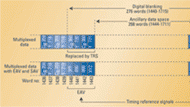The digital video synchronization concept

As discussed in our January 2003 article, composite analog NTSC and PAL signals use the horizontal and vertical blanking intervals to carry horizontal, vertical and chrominance synchronizing information. Early digital video formats, including the 4Fsc, continued this legacy approach to synchronizing video signals. The complete analog video signal is sampled, resulting in a digital representation of the original composite analog signal.
The dominant SDTV digital video standard, Rec. 601, introduced a trailblazing concept of treating video signals. The analog luminance (E´Y) and color-difference (E´B-Y and E´R-Y) signals are band-limited and separately sampled. The sampling frequencies are identical for the two scanning formats 525/60 and 625/50. The resulting digital representations, Y, CB and CR, are subsequently time-division multiplexed into a parallel or serial datastream for distribution or processing. Using the preferred sampling strategy (4:2:2) and number of bits per sample (10), the resulting parallel data rate is 27Mwords/s. Because the component digital signal carries no analog type sync information, the quantizing range is extended, resulting in superior SNR and picture quality.
Revisiting Rec. 601
The analog video signal is sampled at a multiple of the horizontal scanning frequency. As a result, the sampling instants are vertically aligned on a line-by-line and field-by-field basis. This is known as orthogonal sampling. In the 4:2:2 format, the E´Y sampling frequency is twice that of each of the E´B-Y and E´R-Y signals. As a result there are twice as many Y samples as there are CB and CR samples.
The number of Y samples per total line is equal to fS/fH, where fS = 13.5MHz and fH is the horizontal scanning frequency. Given the slightly different values of fH, the number of Y samples per total line is 858 (numbered 0 to 857) in the 525/60 standard and 864 (numbered 0 to 863) in the 625/50 standard. Given fS = 6.75MHz, the number of samples per total line for each of the CB and CR signals is 429 (numbered 0 to 428) in the 525/60 standard and 432 (numbered 0 to 431) in the 625/50 standard.
There are 720 active Y samples (numbered 0 to 719) and, respectively, 360 each CB and CR samples (numbered 0 to 359) in both standards.
The horizontal blanking duration is 138 clock intervals (numbered 720 to 857) in the 525/60 standard and 144 clock intervals (numbered 720 to 863) in the 625/50 standard.
The professional video industry's #1 source for news, trends and product and tech information. Sign up below.
The combined (multiplexed) number of Y and CB/CR samples per total line (words per total line) is 1716 (numbered 0 to 1715) in the 525/60 standard and 1728 (numbered 0 to 1727) in the 625/50 standard.
Figure 1. Details of the 525/60 scanning standard horizontal blanking interval showing the composition of the 4:2:2 digital data multiplex and the position of the timing reference signals, EAV and SAV.
The digital active line accommodates 720 Y samples, 360CB samples and 360 CR samples in both standards, or a total number of 1440 words per active line, numbered 0 to 1439.
Rec. 601 and video synchronization
The Rec. 601 digital standard does not provide for the sampling of the analog sync pulses. The digital sync information is carried by the timing reference signals (TRS). Two TRSs are multiplexed into the datastream on every line immediately preceding and following the digital active line data. Eight data words in the horizontal blanking interval are reserved for the transmission of TRS.
The TRS is a sequence of four 10-bit words identifying the end of the active video (EAV) and the start of the active video (SAV). The digital signal levels carried by SAV and EAV are unique values that cannot be assumed by the video signal.
The position of the TRS in the data multiplex is shown in Figures 1 and 2 for the two scanning standards. As shown in Figure 1, in the 525/60 format the words numbered 1440 through 1443 are reserved for the transmission of EAV. Words 1712 through 1715 are reserved for the transmission of SAV. As shown in Figure 2, in the 625/50 format the words 1440 through 1443 are reserved for the transmission of EAV. Words 1724 through 1727 are reserved for the transmission of SAV. The EAV and SAV signals retain the same format during the field blanking interval.
Figure 2. Details of the 625/50 scanning standard horizontal blanking interval showing the composition of the 4:2:2 digital data multiplex and the position of the timing reference signals, EAV and SAV.
Each TRS consists of a four-word sequence. The sequence of four words can be represented, using a 10-bit hexadecimal notation, in the following manner:
3FF 000 000 XYZ
The first three words are a fixed preamble. The 3FF and 000 hexadecimal values are reserved for timing identification. They unambiguously identify the start of EAV and SAV sync information as the values 3FF and 000 cannot be assumed by the Y, CB and CR signals.
XYZ represents a variable word. It contains information defining field identification, state of vertical blanking and state of horizontal blanking. It is evident that the TRS carries a large amount of information which may or may not be used, depending on the circumstances. The unused blanking space can be used to carry ancillary data such as 16 digital audio channels, timecode or other information.
Michael Robin, a fellow of the SMPTE and former engineer with the Canadian Broadcasting Corp.'s engineering headquarters, is an independent broadcast consultant located in Montreal, Canada. He is co-author of Digital Television Fundamentals, published by McGraw-Hill.
Send questions and comments to:michael_robin@primediabusiness.com
